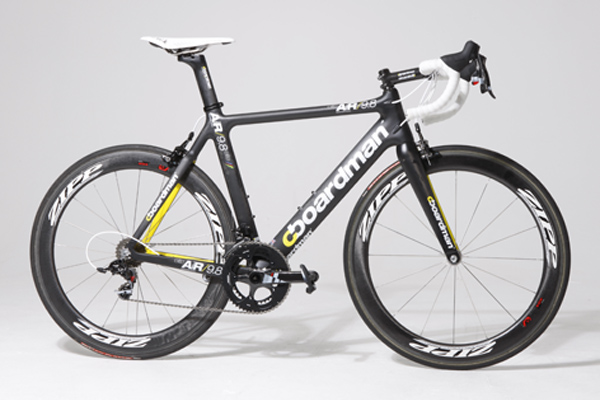Boardman Air 9.8 review

This is an out and out racing bike. It's fast and it's rigid and is designed for competition. The bikes aerodynamics characteristics come from the mind of one of the most knowledgable minds in the field so they have to be taken seriously. Ridden with a set of deep section wheels makes for a bike that is as well suited to time trials as well as road races. Thankfully the handling means it's as agile in the latter as it is fast in the former. If you buy with the Zipp wheels you will need a spare set for general riding, as those should be saved for the races.
-
+
Incredible rigidity
-
+
direct steering
- +
-
-
Not a bike for long training rides
-
-
Chances are you'll need a second set of wheels
You can trust Cycling Weekly.

As the range from Boardman bikes continues to grow it's only natural that an aero road bike resides near the top. Chris Boardman shot to fame when he rode the Mike Burrows designed Lotus bike to victory in the 1992 Olympic Games individual pursuit, and he's been at the forefront of cycling's aerodynamic research ever since.
During his professional career Boardman rode several unique tt bikes (made by Terry Dolan but stickered up as Merckx's) in to which he had a significant input, but it has been in his post riding years that he has truly pushed the boundaries. In the build up to the 2008 Beijing Olympics Boardman spent hundreds of man-hours in wind tunnels getting Great Britain's riders' positions and equipment as aerodynamic as possible.
He did the same again in the build up to London 2012 but the work was kept under wraps to allow the British team to fly below the UCI's radar. (They were determined to enforce the principals of the 1996 Lugano Charter that highlighted the risk posed to cycle sport by spiralling costs of equipment and unequal access to technology that gave the richer teams and nations an unfair advantage over the poorer ones.) A lot of knowledge that Boardman gained during his British Cycling based research has unsurprisingly filtered through to his range of bikes.
Boardman bikes: the range explained
Several characteristics of the 9.8 remind me of the UKSI bikes the GB team ride. The forks for example are bigger and bulker than the GB team's pursuit forks, but their overall look - and I suspect their profile and width to depth ratio - is very similar. So too are the seat stays at the back.
The main similarities between this bike and the GB track bikes are undoubtedley the clean lines. Each tube on the Aero 9.8 is in a straight line. Why? Because the most aerodynamic route from A to B is a straight line. The profiles of those straight tubes are then shaped where they can be (staying within the UCI's 3:1 ratio rule).
There are of course compromises on a mass produced aero road bike that you don't encounter on a track bike tailor made for an individual rider. The cables coming down from underneath the bar tape ruin the frontal area (in aero terms) but there are few alternatives.
The latest race content, interviews, features, reviews and expert buying guides, direct to your inbox!
The Cervelo S2 and S5 are the only aero road bikes providing a genuine alternative, but even they haven't yet come up with an areo solution for the front brake cable. Only TT bikes (with calipers mounted behind the fork crown) have. On the 9.8 the gear and rear brake cables do tuck neatly in to the frame at the head tube. This also means the frame is ready for electronic groupsets (to be included in the 2013 range).
Obvious aero tubes are the big down tube and seat tube. The seat pin follows this profile although the aesthetics are spoilt by the slightly clunky clamp. Other manufacturers have much neater versions (the Scott Foil for example) but you could argue they have little aero benefit as it's not an area that comes in to contact with clean air.
It is unfortunately impossible to truly asses a bikes aeroydynamic properties without taking it in to a wind tunnel, and as Cycling Weekly's budget doesn't stretch that far all we can do is tell you how it rides. That is, unsurprisingly, very well.
Take a look at that downtube, the size of the bottom bracket area, the square chain stays, and you wont be surprised to learn that it is an incredibly stiff bike - perhaps one of the stiffest I've ridden. There is almost no nod towards softening the ride (apart from carbon's natural properties) but this isn't the aim of this bike.
Handling wise the bike is everything you want from a race bike. The straight bladed forks set with a head angle of 72.5 degress (on the small/medium sized bike) are as rigid as the rest of the bike giving quick, direct steering without a hint of twitchiness.
Unfortunately we didn't get to keep the Zipp 404's that came with the bike - they were just for show - so rode instead with some Mavic Ksyrium Equipe S's (it is a shame to ride a bike like this without deep section wheels in). When riding a time trial on the bike I put on some deep section carbon wheels (Pro Lites, budget deep sections, but good all the same). Those along with some clip-on tri bars turned this in to a very fast bike. If you're after a road bike that you can also time trial on this is just what you're looking for.
The 175mm cranks helped here too, although that's the only place they helped. I normally ride 170mm cranks, or, at a push, 172.5mms, but couldn't get hold of a BB30 set quick enough so made do with the longer ones. Great in time trials or on the flat when pushing the pace, not so great for accelerating or climbing short sharp hills, or spinning little gears. Had I
The 9.8 came with SRAM Red, if you want Shimano you'll have to go for the 9.4 that comes with Dura Ace (and cheaper carbon wheels and a white paint job), next year there will be an electronic version.

Editor of Cycling Weekly magazine, Simon has been working at the title since 2001. He first fell in love with cycling in 1989 when watching the Tour de France on Channel 4, started racing in 1995 and in 2000 he spent one season racing in Belgium. During his time at CW (and Cycle Sport magazine) he has written product reviews, fitness features, pro interviews, race coverage and news. He has covered the Tour de France more times than he can remember along with the 2008 and 2012 Olympic Games and many other international and UK domestic races. He became the 134-year-old magazine's 13th editor in 2015 and can still be seen riding bikes around the lanes of Surrey, Sussex and Kent. Albeit a bit slower than before.